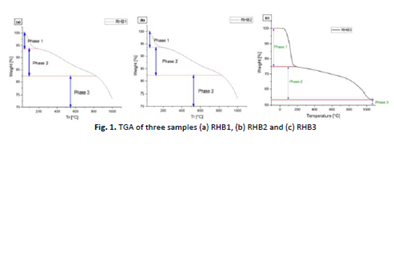Preparation and Characterization of Rice Husk Biochar-Based Chemical Activated Carbon in Varying Particle Size
DOI:
https://doi.org/10.37934/kijbb.1.1.5868Keywords:
Activated carbon, rice husk biochar, chemical activationAbstract
This study focuses on preparing and characterizing biomass materials by utilizing rice husk biochar, with a specific emphasis on the role of particle size variation. The increasing demand for high-performance, sustainable energy storage solutions has driven the exploration of alternative source of carbonaceous materials. This research aims to address these concerns by repurposing agricultural waste, particularly rice husks, into a cost-effective, high-performance material. The objectives include fabricating electrode using rice husk biochar-derived activated carbon in perspective of characterizing their structural properties and evaluating the influence of particle size towards in this structural study. The methodology involves the chemical activation of rice husk biochar, followed by advanced characterization techniques like Thermogravimetric Analysis (TGA), Field Emission Scanning Electron Microscopy (FESEM), Energy Dispersive X-ray Analysis (EDX), Fourier Transform Infrared Spectroscopy (FTIR), and Branneur-Emmet-Teller (BET). The prepared materials highlight the potential of controlling particle size to fine-tune electrode properties for specific applications. The implications of this research indirectly extend to electric vehicles, renewable energy storage systems, and portable electronics, offering a pathway toward greener and more efficient energy storage solutions. By transforming agricultural waste into a valuable resource, this work contributes to the circular economy, reducing environmental impact while addressing critical technological challenges in energy storage development.
References
[1] Ouyang, Jinbo, Limin Zhou, Zhirong Liu, Jerry YY Heng, and Wenqian Chen. "Biomass-derived activated carbons for the removal of pharmaceutical mircopollutants from wastewater: A review." Separation and Purification Technology 253 (2020): 117536. https://doi.org/10.1016/j.seppur.2020.117536 DOI: https://doi.org/10.1016/j.seppur.2020.117536
[2] Luo, Lu, Yuling Lan, Qianqian Zhang, Jianping Deng, Lingcong Luo, Qinzhi Zeng, Haili Gao, and Weigang Zhao. "A review on biomass-derived activated carbon as electrode materials for energy storage supercapacitors." Journal of Energy Storage 55 (2022): 105839. https://doi.org/10.1016/j.est.2022.105839 DOI: https://doi.org/10.1016/j.est.2022.105839
[3] Jiang, Qiwen, Yeyan Ni, Qi Zhang, Jiafeng Gao, Ziqi Wang, Huanhuan Yin, Yi Jing, and Jie Wang. "Sustainable nitrogen self-doped carbon nanofibers from biomass chitin as anodes for high-performance lithium-ion batteries." Energy & Fuels 36, no. 7 (2022): 4026-4033. https://doi.org/10.1021/acs.energyfuels.2c00157 DOI: https://doi.org/10.1021/acs.energyfuels.2c00157
[4] Yu, Kaifeng, Zhifei Zhang, Jicai Liang, and Ce Liang. "Natural biomass-derived porous carbons from buckwheat hulls used as anode for lithium-ion batteries." Diamond and Related Materials 119 (2021): 108553. https://doi.org/10.1016/j.diamond.2021.108553 DOI: https://doi.org/10.1016/j.diamond.2021.108553
[5] Li, Yi, Hechang Shi, Ce Liang, and Kaifeng Yu. "Turning waste into treasure: biomass carbon derived from sunflower seed husks used as anode for lithium-ion batteries." Ionics 27 (2021): 1025-1039. https://doi.org/10.1007/s11581-020-03900-2 DOI: https://doi.org/10.1007/s11581-020-03900-2
[6] Su, Dangcheng, Xuezhao Wang, Yingliang Liu, Shengang Xu, Shaoming Fang, Shaokui Cao, and Yuanhua Xiao. "Co-embedded nitrogen-enriching biomass-derived porous carbon for highly efficient oxygen reduction and flexible zinc-air battery." Journal of Alloys and Compounds 896 (2022): 162604. https://doi.org/10.1016/j.jallcom.2021.162604 DOI: https://doi.org/10.1016/j.jallcom.2021.162604
[7] Das, Gouri Sankar, Jee Youn Hwang, Ji-Hoon Jang, Kumud Malika Tripathi, and TaeYoung Kim. "Biomass-based functionalized graphene for self-rechargeable zinc–air batteries." ACS Applied Energy Materials 5, no. 6 (2022): 6663-6670. https://doi.org/10.1021/acsaem.2c00169 DOI: https://doi.org/10.1021/acsaem.2c00169
[8] Cui, Peng, Tingzhen Li, Xiao Chi, Wu Yang, Zehong Chen, Wenjia Han, Ruidong Xia, Admassie Shimelis, Emmanuel Iheanyichukwu Iwuoha, and Xinwen Peng. "Bamboo derived N-doped carbon as a bifunctional electrode for high-performance zinc–air batteries." Sustainable Energy & Fuels 7, no. 11 (2023): 2717-2726. https://doi.org/10.1039/D3SE00315A DOI: https://doi.org/10.1039/D3SE00315A
[9] Thirumal, V., R. Yuvakkumar, G. Ravi, G. Dineshkumar, M. Ganesan, Saad H. Alotaibi, and Dhayalan Velauthapillai. "Characterization of activated biomass carbon from tea leaf for supercapacitor applications." Chemosphere 291 (2022): 132931. https://doi.org/10.1016/j.chemosphere.2021.132931 DOI: https://doi.org/10.1016/j.chemosphere.2021.132931
[10] Li, Yue, and Bin Qi. "Secondary utilization of jujube shell bio-waste into biomass carbon for supercapacitor electrode materials study." Electrochemistry Communications 152 (2023): 107512. https://doi.org/10.1016/j.elecom.2023.107512 DOI: https://doi.org/10.1016/j.elecom.2023.107512
[11] Rashidi, Nor Adilla, Yee Ho Chai, Intan Syafiqah Ismail, Muhamad Farhan Haqeem Othman, and Suzana Yusup. "Biomass as activated carbon precursor and potential in supercapacitor applications." Biomass Conversion and Biorefinery (2022): 1-15. https://doi.org/10.1007/s13399-022-02351-1 DOI: https://doi.org/10.1007/s13399-022-02351-1
[12] Lu, Shun, Ling Fang, Xi Wang, Terence Xiaoteng Liu, Xianhui Zhao, Ben Bin Xu, Qingsong Hua, and Hong Liu. "Insights into activators on biomass-derived carbon-based composites for electrochemical energy storage." Materials Today Chemistry 37 (2024): 101988. https://doi.org/10.1016/j.mtchem.2024.101988 DOI: https://doi.org/10.1016/j.mtchem.2024.101988
[13] Lobato-Peralta, Diego Ramón, Patrick U. Okoye, and Cinthia Alegre. "A review on carbon materials for electrochemical energy storage applications: State of the art, implementation, and synergy with metallic compounds for supercapacitor and battery electrodes." Journal of Power Sources 617 (2024): 235140. https://doi.org/10.1016/j.jpowsour.2024.235140 DOI: https://doi.org/10.1016/j.jpowsour.2024.235140
[14] Ahmad, Abdulbari A., Abdulraqeeb Alwahbi, Laila A. Al Khatib, and Hani Dammag. "Biomass-Based Activated Carbon." In From Biomass to Biobased Products. IntechOpen, 2024. https://doi.org/10.5772/intechopen.111852 DOI: https://doi.org/10.5772/intechopen.111852
[15] Xiao, Feng, Pavankumar Challa Sasi, Bin Yao, Alena Kubátová, Svetlana A. Golovko, Mikhail Y. Golovko, and Dana Soli. "Thermal stability and decomposition of perfluoroalkyl substances on spent granular activated carbon." Environmental Science & Technology Letters 7, no. 5 (2020): 343-350. https://doi.org/10.1021/acs.estlett.0c00114 DOI: https://doi.org/10.1021/acs.estlett.0c00114
[16] Saadatkhah, Nooshin, Adrián Carillo Garcia, Sarah Ackermann, Philippe Leclerc, Mohammad Latifi, Said Samih, Gregory S. Patience, and Jamal Chaouki. "Experimental methods in chemical engineering: Thermogravimetric analysis—TGA." The Canadian Journal of Chemical Engineering 98, no. 1 (2020): 34-43. https://doi.org/10.1002/cjce.23673 DOI: https://doi.org/10.1002/cjce.23673
[17] Elkhalifa, Samar, Prakash Parthasarathy, Hamish R. Mackey, Tareq Al-Ansari, Omar Elhassan, Said Mansour, and Gordon McKay. "Biochar development from thermal TGA studies of individual food waste vegetables and their blended systems." Biomass Conversion and Biorefinery (2022): 1-18. https://doi.org/10.1007/s13399-022-02441-0 DOI: https://doi.org/10.1007/s13399-022-02441-0
[18] Pradhan, Priyabrat, Abhilash Purohit, Sushri Sangita Mohapatra, Chandana Subudhi, Matruprasad Das, Nitesh Ku Singh, and Bibhuti Bhusan Sahoo. "A computational investigation for the impact of particle size on the mechanical and thermal properties of teak wood dust (TWD) filled polyester composites." Materials Today: Proceedings 63 (2022): 756-763. https://doi.org/10.1016/j.matpr.2022.05.136 DOI: https://doi.org/10.1016/j.matpr.2022.05.136
[19] Farivar, Farzaneh, Pei Lay Yap, Ramesh Udayashankar Karunagaran, and Dusan Losic. "Thermogravimetric analysis (TGA) of graphene materials: effect of particle size of graphene, graphene oxide and graphite on thermal parameters." C 7, no. 2 (2021): 41. https://doi.org/10.3390/c7020041 DOI: https://doi.org/10.3390/c7020041
[20] Xin, Yunzi, Hiromichi Ikeuchi, Jeongsoo Hong, Harumitsu Nishikawa, and Takashi Shirai. "Oxidative decomposition of volatile organic compound on hydroxyapatite with oriented crystal structures." Journal of the Ceramic Society of Japan 127, no. 4 (2019): 263-266. https://doi.org/10.2109/jcersj2.18185 DOI: https://doi.org/10.2109/jcersj2.18185
[21] Yang, Haiping, Rong Yan, Terence Chin, David Tee Liang, Hanping Chen, and Chuguang Zheng. "Thermogravimetric analysis− Fourier transform infrared analysis of palm oil waste pyrolysis." Energy & fuels 18, no. 6 (2004): 1814-1821. https://doi.org/10.1021/ef030193m DOI: https://doi.org/10.1021/ef030193m
[22] Saboori, Abdollah, Gabriele Piscopo, Manuel Lai, Alessandro Salmi, and Sara Biamino. "An investigation on the effect of deposition pattern on the microstructure, mechanical properties and residual stress of 316L produced by Directed Energy Deposition." Materials Science and Engineering: A 780 (2020): 139179. https://doi.org/10.1016/j.msea.2020.139179 DOI: https://doi.org/10.1016/j.msea.2020.139179
[23] Belliard, Frederique, and John Thomas Sirr Irvine. "Electrochemical performance of ball-milled ZnO–SnO2 systems as anodes in lithium-ion battery." Journal of Power Sources 97 (2001): 219-222. https://doi.org/10.1016/S0378-7753(01)00544-4 DOI: https://doi.org/10.1016/S0378-7753(01)00544-4
[24] Ren, Zhuoya, Shuai Liu, Jianqiang Chen, Yang Yu, Qianqian Shang, Sandile Fakudze, Chengguo Liu, Peiguo Zhou, and Qiulu Chu. "One-step synthesis of interface-coupled Si@ SiOX@ C from whole rice-husks for high-performance lithium storage." Electrochimica Acta 402 (2022): 139556. https://doi.org/10.1016/j.electacta.2021.139556 DOI: https://doi.org/10.1016/j.electacta.2021.139556
[25] Poizot, P. L. S. G., S. Laruelle, S. Grugeon, L. Dupont, and J. M. Tarascon. "Nano-sized transition-metal oxides as negative-electrode materials for lithium-ion batteries." Nature 407, no. 6803 (2000): 496-499. https://doi.org/10.1038/35035045 DOI: https://doi.org/10.1038/35035045
[26] Sudarman, Susilo, and Muhammad Taufik. "Synthesis and application of nano-silicon prepared from rice husk with the hydrothermal method and its use for anode lithium-ion batteries." Materials Science for Energy Technologies 7 (2024): 1-8. https://doi.org/10.1016/j.mset.2023.07.003 DOI: https://doi.org/10.1016/j.mset.2023.07.003
[27] Severo, Fabiane Figueiredo, Leandro Souza da Silva, Janielly Silva Costa Moscôso, Qamar Sarfaraz, Luiz Fernando Rodrigues Júnior, Augusto Ferreira Lopes, Laura Brondani Marzari, and Gustavo Dal Molin. "Chemical and physical characterization of rice husk biochar and ashes and their iron adsorption capacity." SN Applied Sciences 2 (2020): 1-9. https://doi.org/10.1007/s42452-020-3088-2 DOI: https://doi.org/10.1007/s42452-020-3088-2
[28] Zhao, Zhuqing, Muya Cai, Haijia Zhao, Qiang Ma, Hongwei Xie, Pengfei Xing, Yan Xin Zhuang, and Huayi Yin. "Zincothermic-reduction-enabled harvesting of an Si/C composite from rice husks for a Li-ion battery anode." ACS Sustainable Chemistry & Engineering 10, no. 15 (2022): 5035-5042. https://doi.org/10.1021/acssuschemeng.2c00428 DOI: https://doi.org/10.1021/acssuschemeng.2c00428
[29] Yazami, R., and Ph Touzain. "A reversible graphite-lithium negative electrode for electrochemical generators." Journal of Power Sources 9, no. 3 (1983): 365-371. https://doi.org/10.1016/0378-7753(83)87040-2 DOI: https://doi.org/10.1016/0378-7753(83)87040-2
[30] Zhang, Jian, Peng Gu, Jing Xu, Huaiguo Xue, and Huan Pang. "High performance of electrochemical lithium storage batteries: ZnO-based nanomaterials for lithium-ion and lithium–sulfur batteries." Nanoscale 8, no. 44 (2016): 18578-18595. https://doi.org/10.1039/C6NR07207K DOI: https://doi.org/10.1039/C6NR07207K
[31] Scimeca, Manuel, Simone Bischetti, Harpreet Kaur Lamsira, Rita Bonfiglio, and Elena Bonanno. "Energy Dispersive X-ray (EDX) microanalysis: A powerful tool in biomedical research and diagnosis." European journal of histochemistry: EJH 62, no. 1 (2018): 2841. https://doi.org/10.4081/ejh.2018.2841 DOI: https://doi.org/10.4081/ejh.2018.2841
[32] Gu, Fu, Jianfeng Guo, Xing Yao, Peter A. Summers, Samuel D. Widijatmoko, and Philip Hall. "An investigation of the current status of recycling spent lithium-ion batteries from consumer electronics in China." Journal of cleaner production 161 (2017): 765-780. https://doi.org/10.1016/j.jclepro.2017.05.181 DOI: https://doi.org/10.1016/j.jclepro.2017.05.181
[33] Wei, Xiaoxuan, Yurui Deng, Xiangming Hu, Junkai Zhao, Hongbin Wei, Zhiyuan Yang, and Guoyu Han. "Biomass derived fibrous porous carbon loaded zinc oxide nanoparticles as high-performance anode materials for lithium ion batteries." Journal of Energy Storage 70 (2023): 107854. https://doi.org/10.1016/j.est.2023.107854 DOI: https://doi.org/10.1016/j.est.2023.107854
[34] Bardestani, Raoof, Gregory S. Patience, and Serge Kaliaguine. "Experimental methods in chemical engineering: specific surface area and pore size distribution measurements—BET, BJH, and DFT." The Canadian Journal of Chemical Engineering 97, no. 11 (2019): 2781-2791. https://doi.org/10.1002/cjce.23632 DOI: https://doi.org/10.1002/cjce.23632
[35] Shanbhag, Arun S., Joshua J. Jacobs, Jonathan Black, Jorge O. Galante, and Tibor T. Glant. "Macrophage/particle interactions: effect of size, composition and surface area." Journal of biomedical materials research 28, no. 1 (1994): 81-90. https://doi.org/10.1002/jbm.820280111 DOI: https://doi.org/10.1002/jbm.820280111
[36] X. Lv, W. Wei, B. Huang, and Y. Dai, "Achieving high energy density for lithium-ion battery anodes by Si/C nanostructure design," J Mater Chem A Mater, vol. 7, no. 5, pp. 2165-2171, 2019, doi: 10.1039/c8ta10936b. https://doi.org/10.1039/C8TA10936B DOI: https://doi.org/10.1039/C8TA10936B
[37] Asadi, Hossein, Mohammad Ghorbani, Mehran Rezaei-Rashti, Sepideh Abrishamkesh, Elnaz Amirahmadi, C. H. E. N. Chengrong, and Manouchehr Gorji. "Application of rice husk biochar for achieving sustainable agriculture and environment." Rice Science 28, no. 4 (2021): 325-343. https://doi.org/10.1016/j.rsci.2021.05.004 DOI: https://doi.org/10.1016/j.rsci.2021.05.004
[38] Karam, Daljit Singh, Prakash Nagabovanalli, Keeren Sundara Rajoo, Che Fauziah Ishak, Arifin Abdu, Zamri Rosli, Farrah Melissa Muharam, and Dzarifah Zulperi. "An overview on the preparation of rice husk biochar, factors affecting its properties, and its agriculture application." Journal of the Saudi Society of Agricultural Sciences 21, no. 3 (2022): 149-159. https://doi.org/10.1016/j.jssas.2021.07.005 DOI: https://doi.org/10.1016/j.jssas.2021.07.005
[39] Costa, Carlos M., João C. Barbosa, Renato Gonçalves, Helder Castro, F. J. Del Campo, and Senentxu Lanceros-Méndez. "Recycling and environmental issues of lithium-ion batteries: Advances, challenges and opportunities." Energy Storage Materials 37 (2021): 433-465. https://doi.org/10.1016/j.ensm.2021.02.032 DOI: https://doi.org/10.1016/j.ensm.2021.02.032














